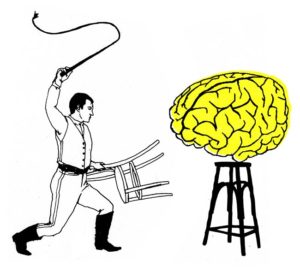Cognitive reappraisal – taming your brain??
July 11, 2018 | Uncategorized | No Comments
We are often faced with external events which evoke a strong negative emotional reaction in us. This reaction is often stress, fear or worry. One proven way to reduce this affect is to taken another look at the situation, which is also referred to as cognitive reappraisal. This process can reduce the negative emotions and ensure we are better able to respond to the situation in a more useful way. Cognitive reappraisal is a proven strategy to reduce the symptoms of anxiety and depression. This article looks at the theory behind this, and provides some advice on how to use this valuable strategy.
Cognitive reappraisal, the intersection between creativity and rumination

We seem to have an obsession with being happy and positive and sometimes it would seem that the secret to happiness is just that. That being the case we could all just choose to do this tomorrow and most of the need for my profession would disappear. Unfortunately as a considerable percentage of our neural resource are focused on threat detection and management, it isn’t this simple. For most people there is a level of over effective threat detection and hence we tend to do the opposite of think positive.
Cognitive reappraisal can be a way of moving from a threat focus to an opportunity focus in a given situation. It enables us to see new people, or the unknown,in a positive way and use our cognitive resources to shape our life in constructive ways. Higher level thinking processes such as creativity can be used to look for opportunities. In fact development of this capacity enables us to increase the number of perceived threats and unknowns that we can cope with.
Cognitive reappraisal is an emotion regulation strategy that involves changing the trajectory of an emotional response by reinterpreting the meaning of a situation that has triggered an emotion. The ability to reappraise a situation has broad benefits. It can be a protective factor against anxiety and depression as research has shown it can reduce negative affect. It is also linked to high order thinking skills such as creativity as it allows us to respond to novel and new situations for which we have no previous understanding.

Rumination is focusing on past events with a problem focus and normally negative affect. This is a thinking style common to both anxiety and depression. It can be a useful strategy when dealing with threats which represent a clear and present danger because it focuses our attention and both body and mind resources on the threat.This ensures the best possible outcome in responding to a real threat. The problem is determining what is a real threat.
Reappraisal can assist us in breaking a rumination cycle as it allows us to move from a problem to a solution focus. It is another example of more flexible thinking styles . Creativity is the use of imagination or original ideas to create something, and in the case of reappraisal this something can be additional perspectives. Cognitive reappraisal is about reviewing the initial understanding and response associated with an external event and reviewing it. Generally the resulting reappraised perspective will be more realistic and / or positive and the associated emotional response will be less intense and negative. Reappraisal and creativity can work hand in hand as creativity in developing alternative perspectives can open the door to greater diversity in thinking, leading to more positive outcomes from the reappraisal .
Cognitive Reappraisal in Action
Step 1 – An external event occur
Step 2 – We make assumptions around this and there is an associated initial emotional response
Step 3 – Rappraisal can happen here as we look for other options to explain the situation.
Step 4 – Based on step 3 we have a modified emotional response which can be more positive and less intense.
Step 5 – We can then take action if required
Reappraisal 101
One of the key area to increase the effectiveness of your reappraisal is to question the assumptions made in step 2. Some useful questions are…….
What is the evidence that supports or contradicts this thought ?
Is there an alternative explanation?
Is there another way of looking at it?
Am I overestimating the probability of the negative event occurring?
What is the worst that could happen?
What is most realistic?
Am I overestimating the severity of the consequences of the event (should it occur)?
Is it really a terrible catastrophe if it happens?
Could I cope with it?
Reappraisal Turbo-boost
When applying the above questions be creative. Look beyond the obvious answers, particularly when considering alternative options, or ways of looking at the situation.
Finishing comments
From an evolutionary perspective our brain is hardwired to expect, look for, and respond to threats to our survival As a human we have high level resources beyond that of other creatures. Rumination, reappraisal and creativity are all examples of these more sophisticated cognitive capabilities. Moving beyond rumination to reappraisal and creativity impacts our mood, our mental health, and our capacity and capabilities to enjoy a better like. Like all new skills, the more we use reappraisal and creativity the easier it gets to use them. Enjoy !!!